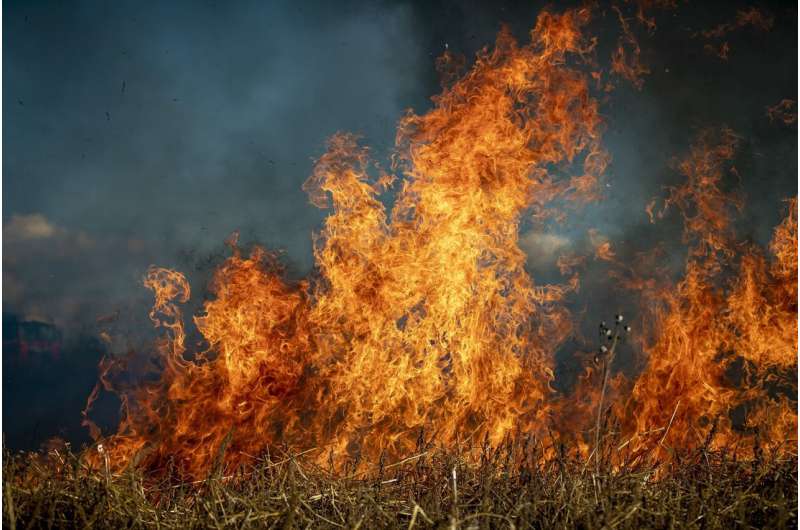This article has been reviewed according to Science X's editorial process and policies. Editors have highlighted the following attributes while ensuring the content's credibility:
fact-checked
reputable news agency
proofread
York fire in Mojave Desert along California-Nevada border balloons to 77,000 acres

A wildfire blazing along the Southern California-Nevada border, burning through delicate Joshua Tree forests, continued to swell Monday—becoming the state's largest of the fire season.
The desert fire had scorched 77,000 acres as of early Monday, with 0% containment. After first being observed Friday, the blaze—dubbed the York fire— has spread mainly across the Mojave National Preserve in eastern San Bernardino County, California, but recently jumped into western Nevada. No evacuations have been issued as a result of the fire, which is burning in mostly remote areas.
"It's a public misconception that the desert doesn't burn, but we're seeing right here that that's not case," said Sierra Willoughby, a supervisory park ranger at Mojave National Preserve. "They're not as rare as we would hope them to be."
Just 10 days before this wildfire was spotted in the New York Mountains area of the Mojave National Preserve, park officials warned of extreme fire risk for the federally protected desert, banning all open flames.
"Even though we had a good moisture year with the [winter] season, the very high temperatures that came in July were a concern for our fire folks," Willoughby said.
Southern California's wet winter and cool spring helped foster increasing levels of invasive grasses and underbrush in the Mojave and Colorado deserts, federal officials said, which has made the region exceptionally susceptible to brush fires this summer.
This year's climate patterns have provided a "more continuous fuel bed" than is typical for desert ecosystems, UCLA climatologist Daniel Swain said on Twitter.
"Big fires in the desert are entirely consistent with the fire season outlook for 2023," Swain wrote, and that poses a major concern for ecologists and desert conservationists. Joshua trees and other desert plants have limited natural defenses to fires, federal officials said, and would struggle to recover from such blazes.
The extent of the plants and animals at risk in the York fire are still under investigation, Willoughby said, noting that the blaze has already burned through Joshua tree forests and juniper and pinyon pine groves. Stephanie Bishop, a spokesperson for the York fire, said endangered tortoises that live in the region also could be harmed.
"What we've seen is fires go through these areas and take out quite a bit," Willoughby said. The York fire is burning in some of the areas that last saw flames in 2005 from the Hackberry fire, which then burned about 2,500 acres. Willoughby said many of the forests harmed in that blaze 18 years ago still have not recovered.
The 2020 Dome fire, which burned more than 40,000 acres across southwestern California desert—including in the national preserve, but in a different area from the York fire—destroyed an estimated 1 million Joshua trees. Crews and volunteers are trying to replant and revitalize those groves.
California's other big fire of the year—the Bonny fire, which has charred 2,300 acres in Riverside County—is also burning across some arid landscapes as well as through the mountains. It has forced 122 people to evacuate their homes, with almost 800 structures threatened, according to officials with the California Department of Forestry and Fire Protection.
The Bonny fire, burning south of Anza, was 20% contained as of Monday morning. One structure has been destroyed, and at least one firefighter was injured in the effort to control the flames.
Winds remain a major concern for the Bonnny and York fires, officials have said.
A challenging weekend of high winds up to 25 mph sparked dangerous fire whirls that pushed the Tork fire across the Mojave National Preserve, said Bishop, a spokesperson for the York fire and a National Park Service public information officer. The weather overnight into Monday had improved slightly, with winds that were not as strong and some precipitation, which allowed for some groundwork and minimal fire growth, she said.
"In some areas, they are looking at maybe 15 mph (Monday)," Bishop said. "I'm hoping we don't hit those 20- to 25-mph winds that we had the last few days."
If winds remain less of a concern, it will give firefighters a better chance to respond, Bishop said, but hurdles—besides the hot desert heat—remain.
"The biggest challenge today that they're going to be dealing with is limited visibility due to thick smoke," Bishop said, noting that visibility has dropped to one mile in some areas.
Federal, state and local firefighting teams are battling the York fire, with more than 260 personnel assigned, officials said. The fire has also moved into the Avi Kwa Ame National Monument, which is Bureau of Land Management land, Willoughby said.
What ignited the fire remains under investigation, but Bishop said it was determined to have started on private land within the preserve.
The area facing flames Monday hasn't seen fire in years, she said.
"The other concern is: If there hasn't been fire in a while … how much fuel is out there?" Bishop said.
In Riverside County, California, gusts up to 40 mph were testing the fire lines of the Bonny fire on Monday, said Alex Izaguirre, a spokesperson for the Riverside County Fire Department. Almost 2,000 personnel are working that blaze, which began Thursday. Its cause is also under investigation.
2023 Los Angeles Times.
Distributed by Tribune Content Agency, LLC.


















